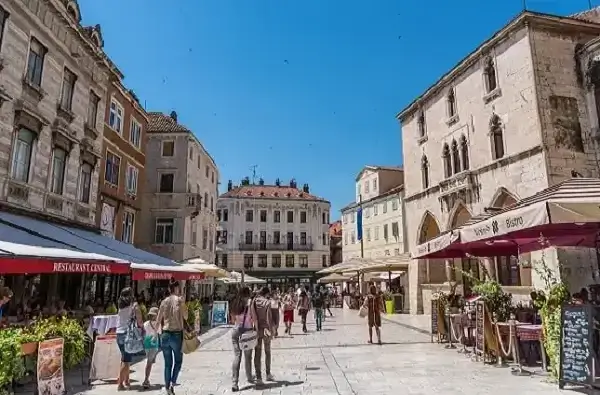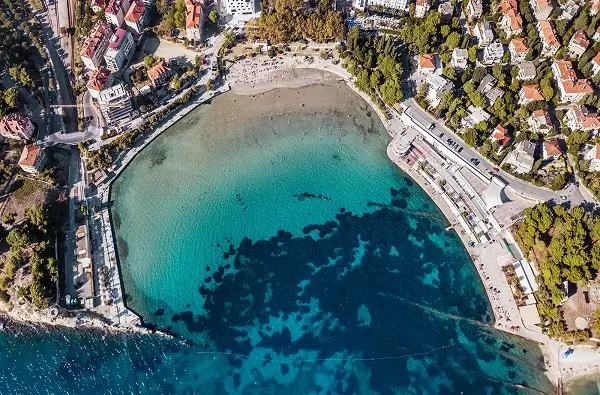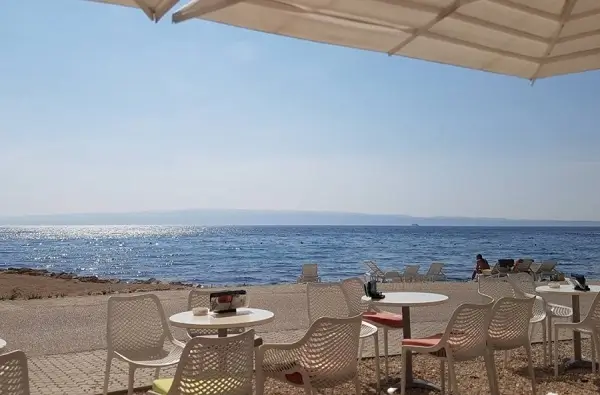Choosing the Right Stay: Where to Stay in Split Croatia
Share this article:
Split offers a myriad of options, from historic landmarks in Diocletian’s Palace to serene escapes on Marjan Hill. Whether you crave beachfront luxury or prefer the charm of a residential neighborhood, our guide will help you find the perfect place to call home during your Split adventure.
Table of Contents
1. Diocletian’s Palace (Old Town)
Nestled within the heart of Split, Croatia, Diocletian’s Palace stands as an architectural marvel steeped in history. Constructed in the 4th century AD by the Roman Emperor Diocletian, this UNESCO World Heritage Site exudes an aura of grandeur and antiquity. The palace complex, encompassing an area of over 30,000 square meters, is a testament to Roman ingenuity and craftsmanship. Its labyrinthine streets, adorned with ancient columns and stone facades, beckon visitors to explore its rich heritage and cultural significance.
Accommodation options:
For travelers seeking accommodation within the historic enclave of Diocletian’s Palace, an array of options awaits. From luxurious boutique hotels to cozy guesthouses and budget-friendly hostels, there is something to suit every taste and budget. Those craving an authentic experience can opt for charming Airbnb rentals nestled within the labyrinthine alleys, offering a glimpse into local life amidst ancient surroundings.
Landmarks nearby:
Staying in Diocletian’s Palace puts visitors within arm’s reach of some of Split’s most iconic landmarks. The majestic Diocletian’s Palace itself, with its imposing walls and well-preserved architecture, serves as the focal point of the area. Nearby, the Cathedral of Saint Domnius, a masterpiece of medieval architecture, stands as a testament to the city’s rich religious heritage. Visitors can also wander through the bustling Peristyle Square, soak in the atmosphere of the ancient cellars, or climb the Bell Tower for panoramic views of the city and the Adriatic Sea beyond.

Pros and cons of staying in Diocletian’s Palace:
Pros:
- Immersive historical experience within a UNESCO World Heritage Site
- Close proximity to major landmarks, restaurants, and shops
- Authentic atmosphere with narrow cobblestone streets and ancient architecture
- Variety of accommodation options catering to different budgets and preferences
Cons:
- Potential noise and crowds, especially during peak tourist seasons
- Limited parking and vehicle access due to pedestrianized streets
- Higher accommodation prices compared to other areas outside the palace precincts
- Some accommodations may have limited amenities due to preservation regulations
2. Bacvice Beach Area
Bacvice Beach Area is renowned for its vibrant atmosphere and stunning shoreline, making it a sought-after destination for sun-seekers and water enthusiasts alike. Situated just east of Split’s city center, this bustling district offers a perfect blend of relaxation and entertainment. The sandy shores of Bacvice Beach stretch along the azure waters of the Adriatic Sea, providing an idyllic setting for leisurely strolls and seaside fun.
Where to stay in Split Croatia – Accommodation options on Bacvice
Travelers to Bacvice Beach Area have a range of accommodation options to choose from, catering to various preferences and budgets. Hotels boasting sea views and convenient access to the beachfront promenade provide a luxurious retreat for discerning guests. Additionally, cozy apartments and guesthouses offer a more intimate and budget-friendly lodging experience, often just a stone’s throw away from the shoreline.
Nearby attractions:
In addition to its stunning beachfront, Bacvice Beach Area offers a plethora of attractions to explore. Visitors can enjoy watersports such as swimming, paddleboarding, and jet skiing along the crystal-clear waters of Bacvice Beach. The area also boasts an array of beach bars, cafes, and restaurants, where guests can indulge in local delicacies and refreshing cocktails while soaking up the sun.

Pros and cons of staying in Bacvice Beach Area:
Pros:
- Proximity to the beautiful Bacvice Beach and its recreational activities
- Vibrant nightlife with beach bars and clubs offering entertainment until the early hours
- Abundance of dining options ranging from casual beachfront eateries to upscale restaurants
- Convenient access to Split’s city center and major attractions via public transportation or a leisurely stroll along the waterfront promenade
Cons:
- Higher accommodation prices during peak tourist seasons
- Crowded beachfront areas, especially in summer months
- Potential noise from nearby nightlife venues
- Limited parking availability, particularly during busy periods
3. Marjan Hill
Marjan Hill, a verdant oasis overlooking the city of Split, offers a tranquil retreat from the bustling streets below. Located on the western edge of the city peninsula, this natural parkland is cherished by locals and visitors alike for its lush forests, winding pathways, and panoramic vistas. Marjan Hill provides an ideal escape for outdoor enthusiasts seeking hiking trails, secluded beaches, and breathtaking viewpoints.
Types of accommodation:
Accommodation options on Marjan Hill cater to those seeking a serene and nature-centric experience. Villas nestled amidst pine groves offer secluded luxury with stunning views of the Adriatic Sea. Additionally, quaint guesthouses and bed-and-breakfast establishments provide cozy retreats for travelers looking to immerse themselves in the tranquility of Marjan Hill.
Recreational activities available:
Marjan Hill beckons adventurers with an array of outdoor activities to enjoy amidst its pristine surroundings. Hiking trails meander through dense forests, leading to secluded coves and picturesque viewpoints overlooking the city and surrounding islands. Cyclists can explore the hill’s network of bike paths, while nature lovers can partake in birdwatching or simply bask in the peaceful ambiance of this natural sanctuary.
Benefits of staying on Marjan Hill:
Pros:
- Serene and secluded atmosphere amidst nature
- Abundance of outdoor recreational opportunities including hiking, biking, and swimming
- Stunning panoramic views of Split, the Adriatic Sea, and nearby islands
- Escape from the hustle and bustle of the city while still being within easy reach of downtown attractions
Cons:
- Limited dining and shopping options compared to the city center
- Reliance on transportation to access amenities outside of Marjan Hill
- Potential for steep terrain and challenging hiking trails for some visitors
- Accommodation choices may be limited and higher priced compared to other areas in Split
4. Split’s Promenade (Riva)
Split’s Promenade, known locally as Riva, is a lively waterfront thoroughfare that serves as the social and cultural hub of the city. Stretching along the picturesque shores of the Adriatic Sea, Riva is lined with palm trees, outdoor cafes, and charming historic buildings. From leisurely strolls to vibrant street performances, this iconic promenade buzzes with activity day and night, offering a quintessential Mediterranean experience.
Accommodation options:
Accommodation along Split’s Promenade caters to travelers seeking to immerse themselves in the vibrant energy of the city’s waterfront. Hotels and boutique accommodations boast prime locations with sweeping views of the sea and easy access to Riva’s bustling promenade. Additionally, apartments and guesthouses offer a more intimate and personalized lodging experience, often nestled within historic buildings along the waterfront.
Proximity to attractions:
Staying along Split’s Promenade puts visitors within walking distance of some of the city’s most renowned attractions. From the iconic Diocletian’s Palace to the bustling Fish Market and the vibrant Green Market, Riva serves as a gateway to Split’s rich cultural heritage and culinary delights. The nearby ferry terminal also offers convenient access to the nearby islands of Hvar, Brac, and Vis.
Pros and cons of staying along Split’s Promenade:
Pros:
- Prime waterfront location with stunning sea views
- Close proximity to historic landmarks, shops, and restaurants
- Vibrant atmosphere with street performers, cafes, and cultural events
- Convenient access to ferry terminals for island hopping adventures
Cons:
- Higher accommodation prices due to prime location
- Potential noise from nearby nightlife and street activities
- Crowded pedestrian areas, especially during peak tourist seasons
- Limited parking options and vehicle access along the promenade
5. Varos Area
Varos, an enchanting residential neighborhood nestled just west of Diocletian’s Palace, offers a charming retreat from the hustle and bustle of the city center. Characterized by its narrow cobblestone streets, quaint stone houses, and vibrant local atmosphere, Varos exudes old-world charm and authenticity. This historic district provides a tranquil setting for travelers seeking a quieter yet still centrally located accommodation option in Split.
Accommodation choices:
Accommodation options in Varos range from cozy apartments and guesthouses to boutique hotels tucked away within historic buildings. Visitors can experience the warmth and hospitality of local residents while enjoying the convenience of being within walking distance of Split’s main attractions. Many accommodations in Varos offer unique architectural features and personalized touches, providing a memorable stay for discerning travelers.
Cultural landmarks nearby:
Staying in Varos puts guests within easy reach of some of Split’s most beloved cultural landmarks. The Church of St. Nicholas, with its distinctive bell tower and Baroque facade, stands as a testament to the district’s rich history and religious heritage. Varos Square, a charming gathering place surrounded by cafes and shops, offers a glimpse into local life and community spirit.
Advantages and drawbacks of staying in Varos:
Pros:
- Authentic local atmosphere with cobblestone streets and historic architecture
- Tranquil residential setting away from the crowds of the city center
- Close proximity to cultural landmarks and attractions such as Diocletian’s Palace
- Personalized hospitality and unique accommodation options
Cons:
- Limited dining and shopping options compared to more touristy areas
- Potential for noise from neighborhood activities and residential areas
- Limited parking availability, particularly in narrow streets
- Some accommodations may lack modern amenities found in larger hotels
6. Firule Neighborhood
Firule, a serene neighborhood located southeast of Split’s city center, offers a tranquil escape for travelers seeking a peaceful retreat by the sea. Named after the nearby Firule Beach, this residential area boasts a laid-back ambiance and stunning coastal vistas. Surrounded by lush greenery and crystal-clear waters, Firule provides an idyllic setting for relaxation and rejuvenation.
You can also check our guide on the top 15 beaches in Split, Croatia.
Accommodation options:
Accommodation options in Firule cater to travelers looking for a serene coastal getaway. Seaside hotels and guesthouses offer breathtaking views of the Adriatic Sea, providing a perfect backdrop for a relaxing vacation. Additionally, cozy apartments and vacation rentals provide a home-away-from-home experience, allowing guests to immerse themselves in the natural beauty of Firule.
Nearby amenities:
Firule offers a range of amenities and activities to enhance the stay of visitors. Firule Beach, with its soft sandy shores and calm turquoise waters, invites sunbathers and swimmers to soak up the Mediterranean sun. Nearby cafes and beach bars offer refreshments and snacks, while waterfront promenades provide scenic walking paths with panoramic views of the coastline.
Benefits of staying in Firule:
Pros:
- Tranquil coastal setting away from the hustle and bustle of the city center
- Stunning sea views and easy access to Firule Beach
- Peaceful ambiance ideal for relaxation and unwinding
- Close proximity to amenities such as cafes, restaurants, and waterfront promenades
Cons:
- Limited nightlife and entertainment options compared to downtown Split
- Reliance on public transportation or car rental to access city center attractions
- Potential for crowding during peak tourist seasons
- Limited accommodation options compared to more central areas of Split
7. Meje Area
Meje, an upscale residential neighborhood located southwest of Split’s city center, offers a luxurious retreat amidst stunning natural surroundings. Perched on the slopes of Marjan Hill, Meje boasts panoramic views of the Adriatic Sea and the nearby islands. Characterized by its elegant villas, manicured gardens, and tranquil ambiance, Meje exudes sophistication and exclusivity.
Accommodation choices:
Accommodation options in Meje cater to discerning travelers seeking refined luxury and personalized service. Luxury hotels and boutique villas offer opulent accommodations with impeccable attention to detail and stunning sea views. Guests can indulge in world-class amenities such as spa facilities, gourmet dining, and private beach access, ensuring a truly unforgettable stay in Meje.
Recreational opportunities:
Meje provides an abundance of recreational opportunities for guests to enjoy amidst its pristine natural surroundings. Hiking trails crisscross the slopes of Marjan Hill, offering breathtaking views of the coastline and surrounding islands. Those seeking relaxation can unwind on secluded beaches or indulge in water sports such as sailing, kayaking, and snorkeling in the azure waters of the Adriatic Sea.
Advantages and drawbacks of staying in Meje:
Pros:
- Exclusive and upscale ambiance with luxurious accommodations and amenities
- Spectacular sea views and proximity to nature trails and secluded beaches
- Tranquil setting away from the crowds of the city center
- Personalized service and attention to detail for a truly luxurious experience
Cons:
- Higher accommodation prices compared to other areas of Split
- Limited dining and entertainment options within walking distance
- Reliance on transportation to access downtown attractions and amenities
- Potential for noise from nearby construction or maintenance activities due to ongoing development in the area
8. Znjan
Znjan, a modern waterfront district located south of Split’s city center, offers a contemporary urban experience with easy access to the beach and amenities. Developed in recent years, Znjan boasts a mix of residential buildings, hotels, restaurants, and recreational facilities, making it a popular destination for both locals and tourists alike.
Accommodation options:
Accommodation options in Znjan cater to travelers seeking convenience, comfort, and modern amenities. Beachfront hotels and apartments offer stunning sea views and easy access to the waterfront promenade and sandy beaches. Visitors can choose from a range of accommodations to suit their preferences and budget, from upscale hotels with spa facilities to self-catering apartments with fully equipped kitchens.
Facilities nearby:
Znjan offers a wealth of facilities and amenities to enhance the stay of visitors. The Znjan waterfront promenade is lined with cafes, restaurants, and bars, offering a diverse selection of dining options and nightlife venues. Additionally, the area boasts sports facilities such as tennis courts, beach volleyball courts, and children’s playgrounds, providing entertainment for visitors of all ages.
Benefits of staying in Znjan:
Pros:
- Convenient waterfront location with easy access to the beach and amenities
- Diverse dining and entertainment options along the waterfront promenade
- Modern accommodations with contemporary amenities and sea views
- Family-friendly facilities and recreational activities for guests of all ages
Cons:
- Potential for crowding during peak tourist seasons, especially on the beaches and waterfront promenade
- Limited cultural attractions and historic landmarks compared to downtown Split
- Relatively new development with ongoing construction and infrastructure projects
- Limited public transportation options for accessing downtown attractions and other areas of Split
9. Trstenik
Trstenik, an emerging neighborhood situated southeast of Split’s city center, offers a blend of modernity and tranquility. Known for its residential charm and proximity to the sea, Trstenik has become increasingly popular among travelers seeking a quieter retreat while still being within reach of urban amenities. With its relaxed ambiance and coastal beauty, Trstenik provides a refreshing escape from the bustling city center.
Accommodation choices:
Accommodation options in Trstenik cater to travelers looking for a peaceful coastal retreat with easy access to the beach. Boutique hotels and cozy guesthouses offer intimate accommodations with personalized service and charm. Additionally, self-catering apartments provide flexibility and convenience for guests seeking a home-away-from-home experience during their stay in Trstenik.

Local attractions:
While Trstenik may be quieter than other areas of Split, it offers its own unique attractions and points of interest for visitors to explore. Trstenik Beach, with its pebbled shores and clear waters, provides a picturesque setting for sunbathing and swimming. Nearby cafes and restaurants offer delicious Mediterranean cuisine and refreshing beverages, allowing guests to savor the flavors of the region. If you’re wondering where to stay in Split Croatia, then this might be a great option.
Advantages and drawbacks of staying in Trstenik:
Pros:
- Peaceful and relaxed atmosphere away from the hustle and bustle of downtown Split
- Proximity to Trstenik Beach and other coastal attractions
- Charming accommodations with personalized service and local hospitality
- Easy access to urban amenities and public transportation for exploring Split and beyond
Cons:
- Limited nightlife and entertainment options compared to more vibrant areas of the city
- Relatively quieter ambiance may not appeal to travelers seeking a lively atmosphere
- Limited shopping and dining options within walking distance
- Potential for limited availability of accommodations, especially during peak tourist seasons
10. Bene
Bene, situated on the western edge of Split, offers a serene retreat amidst lush greenery and natural beauty. Named after the popular Bene Beach, this residential area is known for its tranquil ambiance and proximity to Marjan Hill. With its scenic walking trails, secluded coves, and Mediterranean flora, Bene provides an idyllic setting for nature lovers and outdoor enthusiasts. So if you’re not sure where to stay in Split Croatia, Bene area could be a great option.
Accommodation options:
Accommodation options in Bene cater to travelers seeking a peaceful escape surrounded by nature. Charming bed-and-breakfast establishments and family-run guesthouses offer cozy accommodations with personalized service and local hospitality. Additionally, vacation rentals and holiday homes provide flexibility and comfort for guests looking to immerse themselves in the natural beauty of Bene.
Nearby attractions:
While Bene may be known for its natural beauty, it also offers a range of attractions and activities for visitors to enjoy. Bene Beach, with its calm waters and shaded areas, provides a relaxing spot for sunbathing and swimming. The nearby Marjan Forest Park offers a network of hiking and biking trails, as well as panoramic viewpoints overlooking the city and coastline.
Advantages and drawbacks of staying in Bene:
Pros:
- Tranquil natural surroundings with easy access to Marjan Hill and Bene Beach
- Scenic walking trails and outdoor recreational opportunities in Marjan Forest Park
- Charming accommodations with personalized service and local hospitality
- Peaceful ambiance away from the crowds of downtown Split
Cons:
- Limited dining and shopping options within walking distance
- Relatively quieter ambiance may not appeal to travelers seeking a lively atmosphere
- Distance from downtown attractions and amenities may require transportation for exploring Split
- Potential for limited availability of accommodations, especially during peak tourist seasons
What part of Split is best to stay?
The best part of Split to stay depends on your preferences and interests. If you want to be in the heart of the historic center with easy access to landmarks, restaurants, and nightlife, staying within or near Diocletian’s Palace (Old Town) would be ideal. If you prefer a quieter atmosphere with scenic views and outdoor activities, areas like Marjan Hill or Meje could be a better fit.
How many days should you spend in Split, Croatia?
The ideal duration for your stay in Split depends on what you want to see and do in the city and its surroundings. Many visitors find that spending 2-3 days in Split allows enough time to explore the historic center, visit nearby attractions like Trogir or Krka National Park on day trips, and enjoy some leisure time by the sea.
Is Split a good base to explore Croatia?
Yes, Split can serve as an excellent base for exploring Croatia, particularly the Dalmatian coast and nearby islands. From Split, you can easily access other popular destinations such as Dubrovnik, Hvar, Brac, and Vis via ferry, bus, or car. Additionally, Split’s central location makes it convenient for day trips to national parks, UNESCO World Heritage sites, and charming coastal towns.
Where to stay in Split on a budget?
If you’re traveling on a budget, there are several areas in Split where you can find affordable accommodation options. Consider staying in budget-friendly hostels or guesthouses in neighborhoods like Split 3 or Varos. Alternatively, look for apartments or vacation rentals in residential areas slightly outside the city center, which may offer lower rates while still providing easy access to downtown attractions. Additionally, visiting during the shoulder seasons (spring or fall) can often result in better deals on accommodations compared to peak tourist months.


